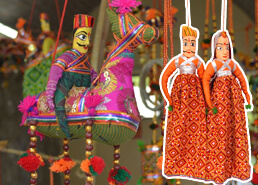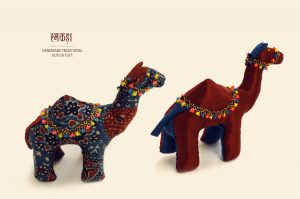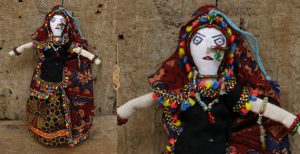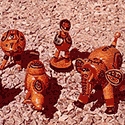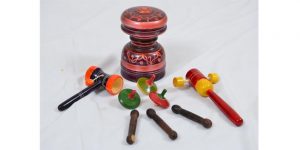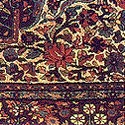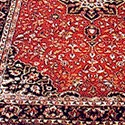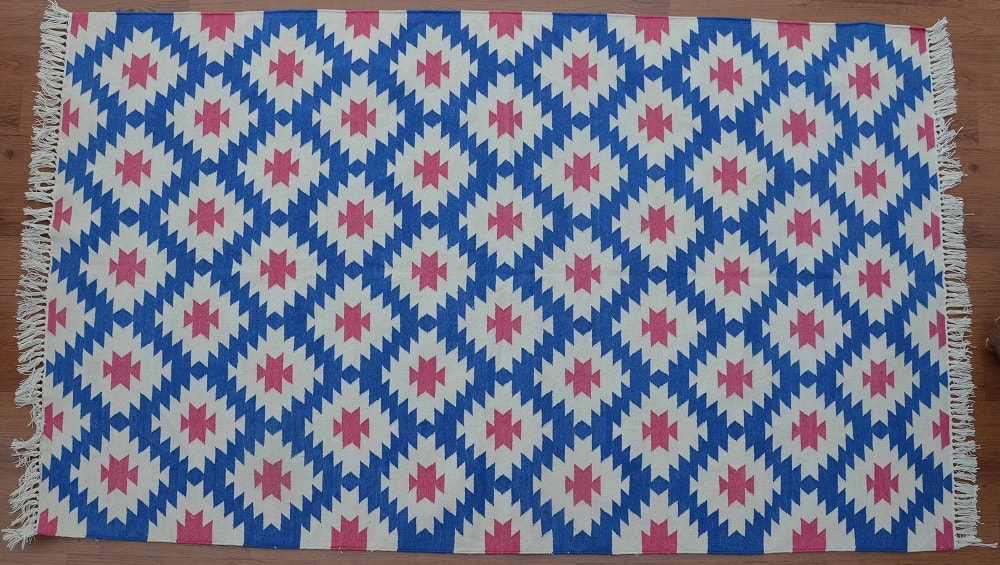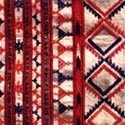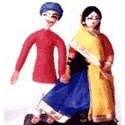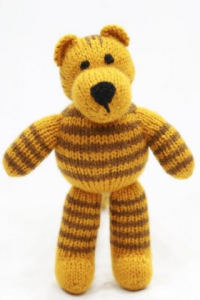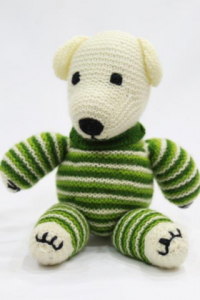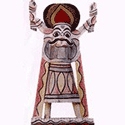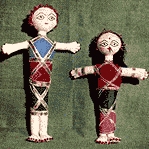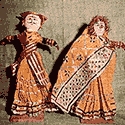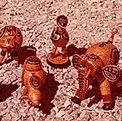The Bhawani dhurries of Coimbatore are woven in a tradition that is about 200 years old. They are woven mainly in cotton and silk in brilliant colours. The center was famous for its silk dhurries, but economies of scale have meant that it produces mainly cotton dhurries now. Salem is another important centre where Bhavani dhurries are made. The pattern usually has a lotus in the center, and the border has either flowing floral patterns or stylised parrots.
The craft of carpet weaving requires a high degree of skill and dexterity. A typical feature of the Indian carpet is the border design, where different patterns match the design in the centre. The colour scheme is arranged so as to eliminate any shadow in the pattern. Symmetry has to be maintained so the ornamentation is distributed finely over the surface. Both colours and motifs convey a symbolic meaning; the motifs dominantly include human figures, flora, fauna, landscape, and water.
The craft of carpet weaving requires a high degree of skill and dexterity. A typical feature of the Goa carpet is the border design, where different patterns match the design in the centre. The colour scheme is arranged so as to eliminate any shadow in the pattern. Symmetry has to be maintained so the ornamentation is distributed finely over the surface. Both colours and motifs convey a symbolic meaning; the motifs dominantly include human figures, flora, fauna, landscape, and water.
Rajasthan is traditionally well-known for fine-quality hand-knotted woollen carpets. Jaipur, Ajmer, and Bikaner are main centres for this craft. It is also found in smaller towns like Tonk, Chaksu, Manaharpura, and Barmer. Some of the motifs used are little rosettes of Indo-Heratic origin; the colours found are blue, red, and purplish-tints in combination. The other combination is light green and deep blue. The border motifs include bold flowers and long serrated leaves. There is a move to revive traditional designs like dushala, charkona, mehrab and shikar. Otherwise the designs are slanted towards the Indo-Persian. The carpet in Indo-Kerman design has ivory or cream as the background colour with floral design all over or in the centre. Complex carpets, requiring 400 to 600 knots per inch, are not woven any more; simple carpets with counts of 16 to 36 knots are being woven. Rajasthan has a strong wool base as it controls 50 per cent of total wool production in India and there is enormous scope for disseminating this craft in rural areas. In Indira Colony in Salawas which is twenty two kilometres from Jodhpur reside about 5000 weavers making dhurries with hairs from Goat and camel. Recently weavers started using cotton, wool and silk yarn as well.Dhurries are known for their geometric patterns and figurative symbols in myriad colours. The weaving happens on the floor horizontally with foot treadle loom. The weavers in Salawas have also worked with designers like Shyam Ahuja.
This state is one of the main centres of carpet-weaving in the country. The important towns are are Mirzapur, Badohi, and Khamaria, along with about 500 villages in and around this area. During British rule, growing demand from outside the country led to a growth in the carpet industry. Finer weave in carpets is obtained by using twisted cotton thread. Jute twine is used for rougher qualities. The carpets are of a medium quality with about 60 knots per square inch. Graphs are used to guide the tying of the knots and the proper usage of colours. Traditional Oriental carpets are not produced very commonly; Aubusson and Savonneric carpets are very popular as exports and are produced very widely. Agra is a traditional centre for carpet-weaving since the Mughal days. Traditional and new designs are found here. Master weavers guide the other weavers in the process of weaving. Cotton and woollen carpets are made in Shahjehanpur. The woollen carpets are in three sizes and the designs are Persian. [gallery ids="174535,174536,174537"] Mirzapur is famous for its dhurries woven in the famous panja technique. Their ornamental value has made them achieve their own geographical indication tag. In this technique a metallic claw (panja) like tool is used during the weaving process to set the threads in the warp. Mirzapur dhurries are completely hand woven with weft threads on horizontal looms. Cotton and wool, both are used to create dhurries. The juxtaposition of colorful wefts to make geometrical patterns like of diamond shapes, animals and birds like lions and peacocks, make Mirzapur dhurries exceptional. The craft of carpet weaving requires a high degree of skill and dexterity. A typical feature of the Indian carpet is the border design, where different patterns match the design in the centre. The colour scheme is arranged so as to eliminate any shadow in the pattern. Symmetry has to be maintained so the ornamentation is distributed finely over the surface. Both colours and motifs convey a symbolic meaning; the motifs dominantly include human figures, flora, fauna, landscape, and water.
The community of bhutias weave carpets in wool, a task performed mainly by the women. The designs are inspired from Tibet. The Tribal Welfare Centre makes ordinary carpets on the big looms, but better looking ones on the loin-looms. Another place which is a fully functional carpet-making unit is the Tibetan Refugees Self-Help Centre. The motifs are derived from various elements in Tibetan iconography and ancient beliefs, woven into an integrated composition which results in a bold design. Strong colours are used to offset muted shades. One of the most famous dragon motifs of Tibetan origin is the duk goh, a standing version. When a bird is also present in the same motif then it is called as dhuk thang gyaja. Pema gyaja is a lotus with a bird and pema thang gumbo is a combination of lotus and bats. Gyaja thang medok is a combination of a bird and flower and nehtsho thang medok is a combination of a parrot and flower. Another motif has flowers in the field with a broken border of flowers and swastikas alternating, and another one is the Wall of China. Kalimpong also has a centre for Tibetan carpets. Bhutanese, Nepalese, and Lepcha weavers make Tibetan style carpets. The carpets are exported and also cater to local needs.
The craft of carpet weaving requires a high degree of skill and dexterity. A typical feature of the Indian carpet is the border design, where different patterns match the design in the centre. The colour scheme is arranged so as to eliminate any shadow in the pattern. Symmetry has to be maintained so the ornamentation is distributed finely over the surface. Both colours and motifs convey a symbolic meaning; the motifs dominantly include human figures, flora, fauna, landscape, and water.
Dhurries are made widely in Warangal in Andhra Pradesh. They are made in a wide variety of shades, either with contrasting borders or with simple motifs woven into the body. The horizontal looms of Warangal and Parkal are used for making shatrangis, the local name for dhurries. The artisans weave the designs on vertical looms. Warangal durries continue to be hand woven by the Padmasali communities who have been associated with this craft for over a century and more. In this traditional occupation knowledge has been passed down the generations through oral transmission and apprenticeship. The durries are woven on pit looms and on frame looms which are equipped with treadles to enhance speed while ensuring detail and retaining the intricate patterning. The weavers in addition use the weft interlocking techniques. Of their vivid color combinations the red and blue continue to be popular. The designs often have a varied texture with raised patterns on a flat weave. Warangal durries are in wide demand due to their handmade process, use of color and their patterning.The makers have adapted their durries to include a wide variety of fibers like jute, cotton and wool to suit the domestic and international market. However the special feature of the geometric and angular motif pattern of the Warangal durries remains unchanged.
The dhurries are floor coverings made from wool and cotton textiles. The warp is always in cotton of 2x 10 counts, and the patterns are of horizontal stripes.
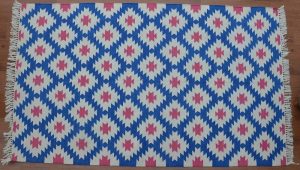
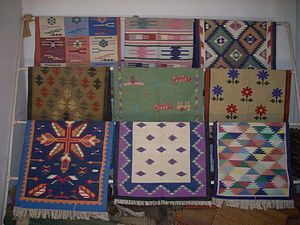

The dhurries of Madhya Pradesh are well-known for their sturdiness and bright colours. The weaving is mainly done by hand-operated pit-looms. The yarn is dyed into various colours according to a predetermined combination, and is manipulated by hand during weaving to get the required effects. The floor coverings or jajams of Madhya Pradesh are renowned. They traditionally have a pinkish-white background and red designs. A large number of motifs are used to compose the design and the designs are grouped together and separated by black or dark red lines. The neempatti design for instance has a 24-petal flower surrounded by leaves and other flowers. Some jajams have geometric motifs but the border designs comprise mainly of leaves and flowers. Another variation is the surajmukh design which is a large sunflower.
The dhurries woven in Delhi have an impressive range of designs and are made in different shapes and sizes, usually either in cotton or in wool. The patterns range from the geometric and linear to the floral, and different colours are woven in.
Woollen felted namdhas are made at Tonk and Malpura. The designs are embroidered and appliquéd. Some namdhas are printed and fringed. Dhurrie weaving is also an important craft. In Bhikaner and Marwar wool is woven into dhurries and satrangis
The doll center at Shimla is well known for its production of a variety of traditionally attired dolls depicting different Pahari communities of Himachal. The dolls are created on a wire frame and are exact replicas to dress and ornament of the different communities.
Doll-making - popular the world over - is a non-traditional craft that has acquired attention as part of the Sri Lankan government's attempts of finding new avenues of employment for the unemployed. Dominantly decorative, the craft uses common materials, especially textiles and handloom products, aiming to transform these into artistic and marketable wares that create income-generation opportunities. As more and more toys of Western origin - and also from South-east Asia - make their way into Sri Lanka, there has been a spurt of interest in this as a possible craft-option. The soft toys made in contemporary times follow Western toy-making trends and educational aims. This craft is practised mainly by women. Sri Lankan women are well-known for their stitching, knitting, and dress-making skills and so the prospects for this craft are very bright.
The most common traditional toys in Assam, which are made of clay, pith, wood and bamboo, cloth, and cloth and mud, are dolls, especially brides and grooms, a variety of animal forms and birds, and images of deities. Cane and bamboo toys are found in the hill areas. Asharkandi, a village in Goalpara district, is famous for its graceful clay dolls. Clay toys, traditionally made by the kumar and hira communities, depict different animals, gods and goddesses, and other mythological figures. Pith toys are chiefly made in the Goalpara region and include figures of gods, animal ,and birds. Wood and bamboo on the other hand have been in use for making toys for several centuries, and are also crafted into birds, animals, and human figures. A harp made of bamboo with a vibrating reed is made in Nagaland and Assam. A bamboo shotgun, much like a toy gun, can shoot pellets up to a distance of 150 yards. Toys of cloth, as also a mixture of cloth and mud, are also part of the rich Assamese toy-making tradition and are generally used for puppet theatre. The art of making cloth toys has been traditionally handed down from mother to daughter, in every household. The bride and groom are the most common characters among household toys, while, in theatre, the themes varies with the character the doll is to play. Common characters are human figures, animals and mythological characters. Pieces of cloth, cotton, clay etc constitute the raw material for this craft.
Through the ages, an infinite variety of terracotta toys and dolls, both painted and unpainted, have been produced by the artisans of South Asia. Ancient sites at Harappa and Mohenjo Daro have yielded a great wealth of clay toys and dolls of remarkable versatility and charm. Similar votive images have been produced over several centuries throughout Bangladesh: indeed such timeless dolls and toys continue to be cherished even in these days of mechanical playthings.
Dolls and toys in Bihar are made with different materials such as clay, cloth, and wood, with each material having its own style and designated areas where the the craft is practised. The making of clay toys and images is a seasonal craft. Votive images, dolls, and figures of animals are all made during the festive period. During Shyama Chak the entire story of the festival is narrated through clay dolls and images built around Shyama or Krishan. Clay toys in abstract folk styles --- like elephants and dancing figures --- are also crafted by the potters. The toys of Darbhanga, especially the horse and rider, are well-known. When the festival season is over, the artisans busy themselves with making domestic utility articles. Many young girls and housewives make cloth dolls as a fruitful pastime, and are particularly active during festivals and fairs. Waste pieces of cloth are used as the raw materials, an important reason for these toys being so inexpensive. Typical cloth dolls of Bihar represent couples, though Adivasi (aboriginal) dolls and their dances are also popular. The features, especially the eyes and the mouths, of the dolls are outlined with black lines. The Chota Nagpur and Ranchi areas are also known for their wooden toys. The most common figures are the mother and child and Raja-Rani that are painted on wood. The toys are notable for their artistic vigour. Many animal figures connected to rituals, acquered wooden toys modelled on folk tradition animals, birds, fish and bird figures are all carved. There is also a variety of toys made from bamboo. Ranchi has very unusual toys. They are completely abstract forms of wood with features painted on them to look like humans or other life forms. Brass and bell metal toys are now restricted to only animals.
The toys made here are usually hollow, and hand-crafted by women. Animals figures such as horses, elephants, dogs, lions, birds, and deer --- fixed with wheels --- are popular with children. Whistle-like toys, made in the tradition of the toys found at Harapppa and Mohenjodaro, are extremely popular. Bastar, Chindwara and Jhabua specialise in huge hollow terracotta forms; since the firing process is faster in hollow forms, the craftspersons prefer to make hollow figures instead of solid ones.
The art of storytelling through puppetry and toys is integral to India's folk and oral traditions. Among nomadic and pastoral communities, puppets and toys were the source of information, entertainment, and awareness for people about their own culture. Mythological stories and current affairs were also transmitted by the means of dolls and puppetry. Made of wood, cloth, they are crafted to perfection and are remarkably expressive figurines.

